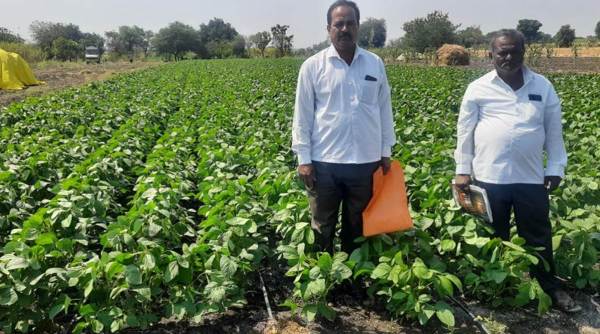Dattatreya Doke is eyeing windfall gains from his soybean crop. This farmer from the village of Dokewadi in Bhum taluka of Osmanabad said this year along with the Kharif crop (sown in June-July and harvested after September), he would have another crop ready for the markets by next April. This was possible because Doke has taken a second soybean crop in the rabi season (sown in December-January and harvested after April) as well. Doke credits the state agriculture department’s extension services which encouraged him and other farmers in his area to go for a second crop of soybean.

Thanks to the second soybean crop, Doke today has 42 quintals of soybean to sell at a time when the wholesale market prices in Maharashtra and Madhya Pradesh — the two biggest soybean-producing states in the country — range between Rs 7,200-7,500/quintal. That’s a sharp premium over the Minimum Support Price (MSP) of Rs 3,950/quintal.
Story continues below this ad
The second soybean crop, which Doke had grown in one-third of his three-acre landholding, has allowed him to have more than the usual quantity of soybean to sell this time around. “On my remaining two acres I grew chana – the most favoured rabi crop in our area,” he explained.
 Dattatreya Doke with his rabi soybean crop. (Express photo)
Dattatreya Doke with his rabi soybean crop. (Express photo)
The government’s move to incentivise an additional crop of soybean in the Rabi season has its roots in a crisis that unfolded two years ago when the state reported a massive seed germination failure. The situation was so bad that according to the estimates of the Soybean Processors Association of India (SOPA), which is the Indore-based soybean processor’s association, around 20 per cent of the 43 lakh hectares under the crop required resowing. From sub-standard seeds to incorrect sowing to inadequate levels of moisture in the soil — there were several reasons for the germination failure. The failure led to the Aurangabad Bench of the Bombay High Court passing strictures against the government.
This incident compelled the state agriculture department to think of ways to ensure the availability of good quality soybean seeds to farmers for the next season. They planned to promote the cropping of soybeans in the Rabi season. The fact that the past two years have seen good rainfall meant that groundwater levels were better than usual and enabled farmers to act on this strategy.
The plan to sow an additional crop in Rabi had two primary goals. One, to compensate for any losses that a farmer may suffer during the routine Kharif season. Two, to supplement farmers’ incomes, even if there were no losses during the Kharif season.
Story continues below this ad
The boost to farmers’ income, in turn, happened in two ways as explained by Dheeraj Kumar, the state’s Agriculture Commissioner. At one level, the farmers had a soybean harvest when its prices were well above the MSP. This allowed farmers to earn a nifty profit — the kind Doke is eyeing at the moment. Two, the Rabi crop also saves the farmers from spending huge amounts of money on buying new seeds for the next Kharif crop. At present, a 100 kg bag of soybean seeds is trading at Rs 10,000. Farmers typically require 20-25 kgs of such seeds for every acre of sowing.
In other words, the Rabi crop is helping farmers to sell at a premium but also reducing their seed costs for the next season, according to Kumar.
The success of this experiment can be gauged from the fact that this year the state has reported over 48,000 hectares of the crop — up 10,000 hectares over the last year.
Moving around his deep-green and healthy field, Doke is confident of another good harvest even as he eyes selling his harvest at almost three times the MSP. Last year he had sold his crop at an average price of Rs 4,600/quintal but soon after soybean prices had zoomed out of control — touching a historic high of Rs 10,000/quintal. Like Doke, most farmers had missed the opportunity. Doke is determined not to miss out this year. “History, it seems, can repeat this year as well. Thanks to this additional crop, I think I will have some produce to sell when the prices reach such a high level again,” he added with optimism.



 Dattatreya Doke with his rabi soybean crop. (Express photo)
Dattatreya Doke with his rabi soybean crop. (Express photo)





























